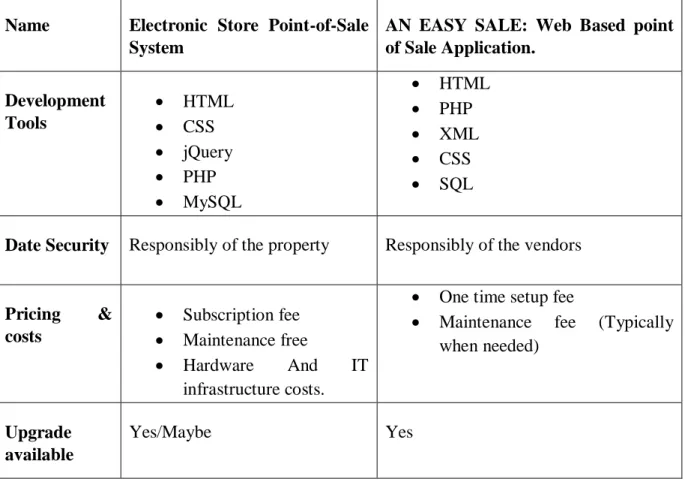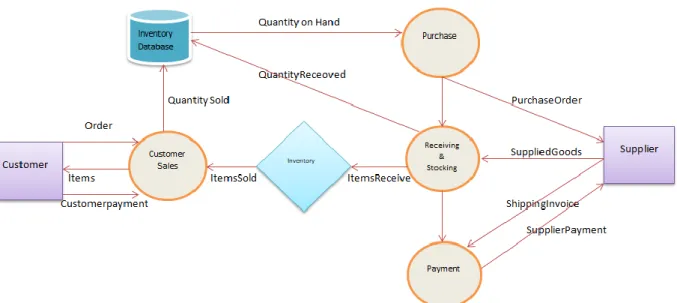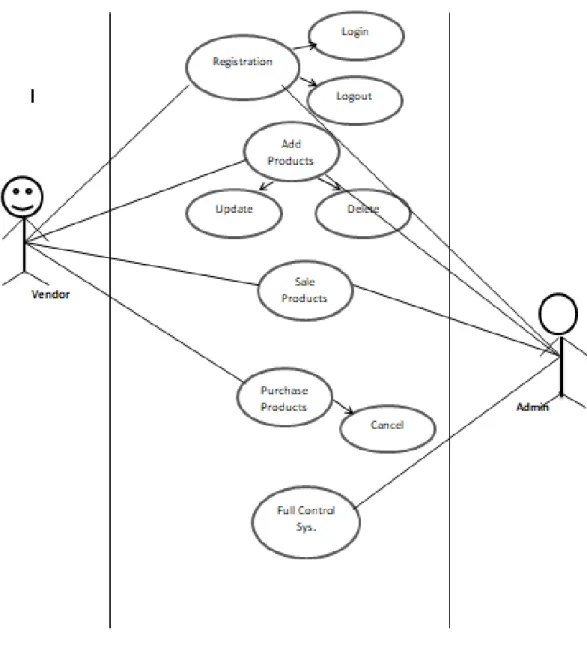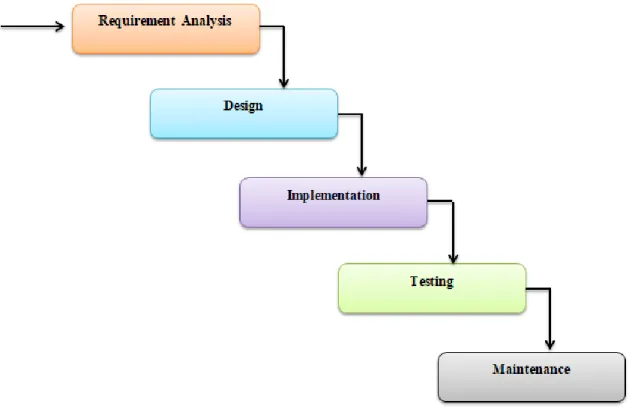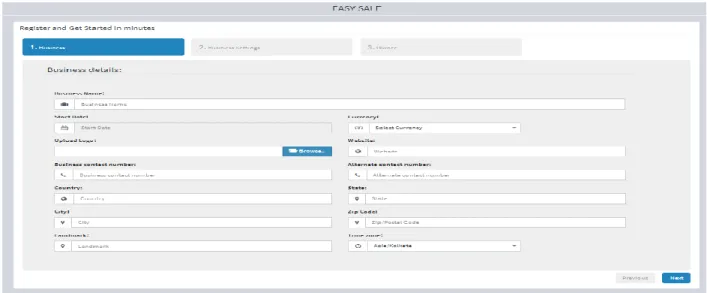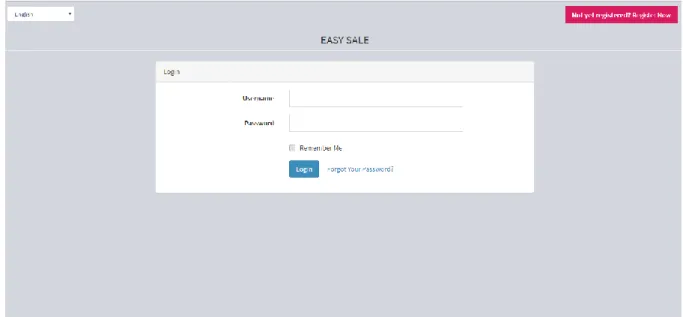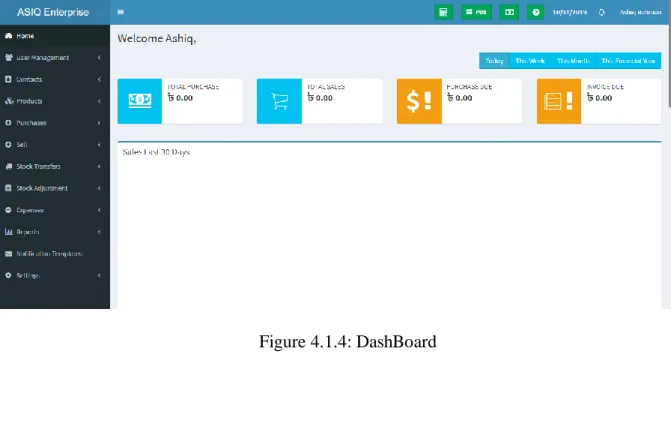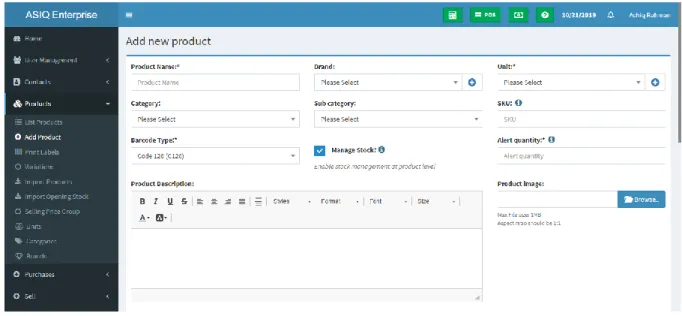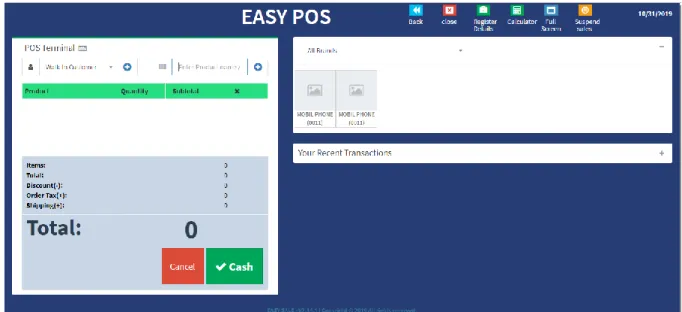AN EASY SALE: WEB-BASED POINT OF SALE (POS) APPLICATION BY
MD. MOMINUL ISLAM ID: 163-15-8363
&
MD. ASIQUR RAHMAN ID: 163-15-8427
This Report Presented in Partial Fulfillment of the Requirements for the Degree of Bachelor of Science in Computer Science and Engineering.
Supervised By
PROFESSOR DR. MD. ISMAIL JABIULLAH Professor
Department of CSE
Daffodil International University
Co-Supervised By
MS. ZERIN NASRIN TUMPA Lecturer
Department of CSE
Daffodil International University
DAFFODIL INTERNATIONAL UNIVERSITY DHAKA, BANGLADESH
December, 2019
i
© Daffodil International University
ii
© Daffodil International University
iii
© Daffodil International University
ACKNOWLEDGEMENT
Firstly, we express our heartiest thanks and gratefulness to almighty ALLAH for his divine blessing makes us possible to complete our final year project successfully. But there are others, without their support, encouragement and appreciation we would not be able to bring our project into light of success. We, from the core of our heart, want to thank them all.
We want to thank our honorable Supervisor professor Dr. Md. Ismail Jabiullah, Professor, Department of Computer Science & Engineering, and Daffodil International University. Deep knowledge and keen interest of our supervisor in the field of “Web Application Development”, to carry out this project. His endless patience, encouragement, expert advice and above all his friendly behavior towards us have made it possible to complete this project.
We would like to express our heartiest gratitude to Dr. Syed Akhter Hossain, Professor and Head, Department of CSE, for his kind help to finish our project and also to other faculty member and the staff of CSE department of Daffodil International University.
Next, we must thank and acquiesce our university, Daffodil International University. We also want to thank our beloved classmates and other students of the university who took part in research purpose for our project and appreciated our work.
Lastly, we want to thank our beloved families, who were always by our side and kept faith on us. Without our family support, we could never be here; we cordially thank them for this. We also thank our friends for their support and help to us.
iv
© Daffodil International University
ABSTRACT
This project is based on Point of Sale (POS) system. Basically this is a desktop based application which is design to various platforms like daily shop, super shop, medicine shop electronics shop etc. This project aims to create an easy, smooth and faster transaction system between Customers and Vendors. So, for the better Transaction system we developed our project that will help the users substantially. First Admin or vendors (users) have to registration and login to manage or use this system. In this system we used the System development life Cycle was applied as an organized way to develop this application. “AN EASY SALE: WEB-BASED POINT OF SALE (POS) APPLICATION” will help users to error free transaction and also consume less time than manual transaction. This system can keep tracking in and out products, due payments and also overall sales of a company. We used HTML, CSS, XML, and PHP to develop our “AN EASY SALE: WEB-BASED POINT OF SALE (POS) APPLICATION” application and all users, product, transaction data will be saved in SQL back end without losing any data.
v
© Daffodil International University
TABLE OF CONTENT
CONTENT PAGE
Approval / Board of Examiners i
Declaration ii
Acknowledgement iii
Abstract
Table of Content List of Figures
iv v-vi
vii
CHAPTER 1: INTRODUCTION
1-31.1 Introduction 1
1.2 Motivation 1
1.3 Objectives 2
1.4 Expected Outcome 2
1.5 Report Layout 3
CHAPTER 2: BACKGROUND STUDY
4-62.1 Introduction 4
2.2 Related Works 4
2.3 2.4
Comparative Studies Organization Scenario
5 5
2.5 Scope of Problem 6
2.6 Challenges 6
CHAPTER 3: REQUIREMENT SPECIFICATION
7-123.1 Business Process Modeling 7
3.2 Requirement Collection and Analysis 8
3.3 3.4
Use Case Modeling Use Case Description
9 10
3.5 Logical Data Model 11
3.6 Design Requirements 12
vi
© Daffodil International University
CHAPTER 4: DESIGN SPECIFICATION
13-184.1 Front-end Design 13-16
4.2 Back-end Design 17
4.3 Interaction Design and UX 18
CHAPTER 5: IMPLEMENTING AND TESTING
195.1 Implementation of Database 19
5.2 Testing Implementation 19
5.3 Test Results and Reports 19
CHAPTER 6: DISCUSSION AND CONCLUSION
20 6.16.2
Discussion Conclusion
20 20
6.3 Scope for Further Developments 20
REFERENCES
21vii
© Daffodil International University
LIST OF FIGURES
FIGURESTable 2.4 Figure 3.1
Comparative study Table
Business Process Modeling of AN EASY SALE
PAGE NO
5 7 Figure 3.3
Table 3.3 Table 3.4
Use Case Diagram of AN EASY SALE.
Description Table 1 Description Table 2
9 10 10
Figure 3.5 Software Development Life Cycle 11
Figure 4.1.1 Home Page of AN EASY SALE 13
Figure 4.1.2 Registration Page of AN EASY SALE 13
Figure 4.1.3 Login page of AN EASY SALE 14
Figure 4.1.4 DashBoard of AN EASY SALE 14
Figure 4.1.5 Product Inventory of AN EASY SALE 15
Figure 4.1.6 Sales Point Of AN EASY SALE 15
Figure 4.1.7 User Guideline Tour 15
Figure 4.2 SQL Database Table 17
Figure 4.3 UX Diagram of AN EASY SALE 18
1
© Daffodil International University
CHAPTER 1 INTRODUCTION
1.1 Introduction
In this description we introduces a point of sale system that can be use various outlets and also introduces system required specification (SRS). The purpose of maturate this system to acquaintance between customers and development team to figure out, break down convoluted customer requirements. It also helps to evaluate the system to demonstrate and understanding to requirements is relevant and complete. It can track the store stock, refreshing it when a request is prepared. It can likewise print out receipts, complete, track clients, and so on. Point of sale (POS) software content the flow at checkout incurable, while recording all the information that can help you makes better business decisions. This document presents different sections, subsections which characterize the requirements of the Sales module in perspective and specifications. Some of the areas that will be camouflaged are order placement, product purchasing, create general sale, create POS sale, create touch point of sale, approve and reject individual sales, create money receipt, create item wise payment collection, maintain sales return, create sales exchange, installment pricing, currency exchange and auto invoicing etc. Any system prerequisite not tended to by Sales module is out of extent of this report.
1.2 Motivation
The inspiration to work in this project is really our real-life experience. As a customer when we go to the store or market to purchase something, we often have to wait in queue to pay the bill which is annoying for everyone. Sometimes merchant make wrong measurement of product prices, stock of products which is not also good for customer, vendor as well as any business. Point of sale (POS) system can manage inventory which is save more time and also can accurately sales and purchase control. A POS system is a powerful tool assist to grow up any business, substantiality how small or provincial it is. That’s why we flourish this application.
2
© Daffodil International University
1.3 Objective
The main objectives of this contemplate are to build an application where a vendor can monitor and develop their business such as
Inventory management.
Collection of Customer Data.
Cost Control.
Accounting Automation.
Security.
Sales Money Receipt Report.
Item Wise Incentive Report.
Product Price List with Stock.
Daily Statement (Sales) Report.
Product Order Report.
Purchase Order Report.
Sales Report.
Sales Order Register.
1.4 Expected Outcome
The outcome of this project is very significant. Some points are specified below
Authentication: User can Sign up to the system by suing different level of authentications.
Purchase and Receive Order: Enter Multiple product information required and also delivery information as product are received.
Time Saving: We are living in a quick creating condition where time is more important than anything so “AN EASY SALE: WEB-BASED POINT OF SALE (POS) APPLICATION” system can save time effective way.
Money Saving: Saving money one of the biggest benefits of “AN EASY SALE:
WEB-BASED POINT OF SALE (POS) APPLICATION” system.
Convenience: Inventory management, keep tracking in & out products and all transactions is exceptionally convenience.
3
© Daffodil International University
1.5 Report Layout
We developed a system which name is “AN EASY SALE: WEB-BASED POINT OF SALE (POS) APPLICATION”. We make sure that this project complete in time. Obeisance to our plan we formation our project report.
In chapter 1 we demonstrate Introduction, discuss about the Motivation, Expected Outcome and Report layout.
In Chapter 2 we showed Software background introduction, Related Works, Organization scenario, comparative Studies, Scope of Problem and Challenges.
In chapter 3 Titled Requirement Specification, we discuss about the BPM, Requirement Collection and Analysis, Use Case Diagram, and Design Requirement of software.
In chapter 4 Titled Design Specification, in this Chapter we showed software about the Front-End Design Back-End Design and interaction with implement requirements.
In chapter 5 Titled Implementation and Testing, in this Chapter we showed the Implementation of Database, Testing, Testing result and report.
In chapter 6 Titled Conclusion and Future Scope, in this chapter we discuss about Discussion, Conclusion and Scope of Future development.
4
© Daffodil International University
CHAPTER 2
BACKGROUND STUDY
2.1
Introduction
AN EASY SALE point-of-sale system, or POS, is a platform where a customer pays for a store's product or service. Simply put, whenever a customer buys a store, they complete the transaction at the sales center. POS is known as the point of sale or point of purchase where a customer brings a product once for a transaction. Point of Sale (POS) is a business management application that handles raw materials, products, sales reports, account related work and summary. POS Systems offers customers an option to choose from a variety of products available online with POS Systems, which are highly reliable and secure in the maintenance of credit card details.
Point of sale involves studying the complexity of the brand, identifying the target audience, building the concept of the event, planning the logistics and integrating the specialized viewpoints before the occasion starts. Post-occasion investigation and guaranteeing rate of return have become significant drivers for the occasion business. Many industries, charities and interest consort hold events of some size to retail, create business contingency, raise money or celebrate.
2.2
Related Works
Online shopping management system, sales automation software, business invoicing system, customer relationship management software, and sales management software.A point-of-sale (POS) system contributes businesses with the dexterity to computerize, systematize and harmonize retail data. Where cash registers, counting complex register systems, have limited information collection accommodation, POS systems can converge, store and return comprehensive reports on inventory progression and customer data. Additionally, POS systems more easily consolidate withmultitudeinal sales and ordering systems, inclusive of mail or online ordering systems used in concurrence with in-person sales. POS allows the Vendors to administer their business aspect and develop a unique shopping experience for their clients. The client ling solution available in Computer store POS enunciates the Customer is consumed back again and again.
5
© Daffodil International University
2.3 Organization Scenario
Many organizations arranged manifold national and international event. An organization formed many departments and each department have its own schedule calendar. There is a communication gap between departments as the other departments are not informed properly.
Thus, there is a collision while booking the event. So it’s not possible for all the events to be held.
2.4 Comparative Studies
Table 2.4 shows the difference between “Electronic Store” and “AN EASY SALE” point of sale system.
Name Electronic Store Point-of-Sale System
AN EASY SALE: Web Based point of Sale Application.
Development Tools
HTML
CSS
jQuery
PHP
MySQL
HTML
PHP
XML
CSS
SQL
Date Security Responsibly of the property Responsibly of the vendors
Pricing &
costs
Subscription fee
Maintenance free
Hardware And IT infrastructure costs.
One time setup fee
Maintenance fee (Typically when needed)
Upgrade available
Yes/Maybe Yes
First, “AN EASY SALE: WEB-BASED POINT OF SALE (POS) APPLICATION” system and inventory POS system, they have application module system to install it on the computer;
users need other specification and system installed. Point-of-sale is free of this complexity, users can access it from anywhere in the browser. Second, other sites are offering the opportunity to manage and manage a store or business account. However, the seller has the
6
© Daffodil International University
opportunity to send the defective product to the head office, view the stock report by branch and so on. The salesperson can also create sales reports or summary reports. So, there is no collision about the problem with the product. It is a system run by one for their own shops and vendors.
2.5
Scope of the Problem
Each individual shop can be generated multiple report or summery. Then the centralized software can be disheartened.
As the system is for one organization, allocation of it to multiple companies is not possible initially.
When POS software rendezvous an error, or when too much software encumber the computer processor or memory, the system can stop working.
If a user enters incorrect information or dispatch the wrong application, POS systems may become unforeseeable or fail to process execution correctly.
2.6
Challenges
Each job has its own challenges. Since Point of Sale (POS) is our main goal, we also have to face a number of challenges.
1. Shop Management Strategy: A company or organization can have multiple stores or stores, and managing them all at the same time will be a big challenge as there can be sales, annual reports and many other work plans. Now all these stores can have different products in multiple places. Can't lose record of store information for organization. Now, this record maintenance starts from the personal store and at the head office cost. This can be considered as a great challenge of the point-of-sale system so that everything can be managed neatly.
2. Asset Allocation: If the head office now has some stores, it means that resources Need to be allocated according to the capabilities of the products. It is a challenge for POS to use all resources efficiently and focus on customer satisfaction. During the allocation of assets, it is important to manage all individual shops for all business related purposes.
7
© Daffodil International University
CHAPTER 3
REQUIREMENT SPECIFICATION
3.1 Business Process Modeling:
BPM or Business Process Modeling is a dispose of design a structural perspective of a system. It includes some mechanism, starts and symbol, predicament as like a flow chart. In this process we can see the Customer can send request to a Vendor Purchase some Items or goods. Vendor supply goods then customer make payment. Again a vendor request to a supplier to purchase products, make payment and supplier send purchase invoice to vendor.
Inventory database can track all products also alert to the vendor when quantity of products are down. Business process modeling is generally viewed as an analytical element in successful business process management. Fig: 3.1: shows BPM Diagram.
Figure 3.1: BPM of AN EASY SALE
8
© Daffodil International University
3.2 Requirement Collection and Analysis
When we are working on a project, a conveyance time of the project has previously given.
That’s why project works must be programmed and executed to transport timely with the solutions that are both consistent and reasonable to the project problem.
Our project is a web based Point of sale (POS) system. So, we prepare of collection requirements must organize and consign all the sensibility. It’s considering to determine the requirements at all straighten and perceptions.
Software Requirements:
Admin can create business profile
Admin can create product
Vendor (user) can login into the system
Vendor can make transaction easily.
Time convenience
Easily accessible
Hardware and Software Requirements for our system:
Whenever we want to use this application and hardware for the system, we should first get the hang of that computer supports the system requirements. These are the fundamental condition for a computer must have in adjure to adoption the software and hardware to be used precisely. In Implement Section the system requires for all tools and platforms distinguish to advancement in following blow.
HTML
XML
CSS
PHP
SQL Database.
9
© Daffodil International University
3.3 Use-Case Modeling
A Use-Case Diagram use to represent graphically of the synergy among the component of a system. A Use-Case is a technique used in system analysis to describe, interpret and organizing system prerequisite.
Figure 3.3: Use-Case Diagram of AN EASY SALE
10
© Daffodil International University
3.4 Use Case Description
Description Table 1 of Table 3.3 Use-Case Diagram Use-Case
Id
3.3
Actor User (Vendor) Before
conditions
The user must have to registering into the system After
Conditions
System will store the data and produce confirmation massage Created information will manipulate according to the user
Flow of Events:
a. The User selects the “Item Group” menu.
b. The system implements the UI for notice Item info information.
c. For new data entry following data will be set in specific field.
d. User writes textbox for group name.
e. User clicks on “Save” button for saving information.
f. System displays a confirmation massage.
Description Table 2 of Table 3.4 Use-Case Diagram
Use-Case ID 3.4
Actor Admin
Pre- condition
Admin must have to login into the system
Admin must have the permission to operate the functions Post-
condition
System will store the information and will Produce a confirmation message.
Created information will be manipulated according to admin.
11
© Daffodil International University
Flows of Events:
a. The admin selects the “Item Type” menu.
b. The system provides the UI for viewing “list of item type”.
c. System shows data in Data Grid according to searching option/parameter.
d. Admin clicks on “Delete” button for deleting information.
e. System shows a confirmation message.
3.5 Logical Data Model
The structure of software development life cycle showed in following figure 3.3
Figure 3.5: Software Development Life Cycle
12
© Daffodil International University
3.6 Design Requirements
When we design an application or system, we have to acknowledge some concern to make the project efficacious. The following requirements are almost obligatory to do.
Ensure the system Easy effortless and Flexible: This system will be designed in such an easy way that the users feel satisfaction, easy way to facile and flexible to use.
Make the system Balanced: This system must be sufficient in the whole system and future preservation.
Efficiency: The most important thing of software is its efficiency. The system must be proficient to run and work with a minimal level of hardware capability available with a good use of time.
13
© Daffodil International University
CHAPTER 4
DESIGN SPECIFICATION 4.1 Front-end Design
Home page
Figure 4.1.1 shows the Home Page of system
Figure 4.1.1: Home Page Registration Page
Figure 4.1.2 shows the Registration page of system
Figure 4.1.2: Registration page
14
© Daffodil International University Login Page
Figure 4.1.3 shows the Login page of the system
Figure 4.1.3: Login page
DashBoard
Figure 4.1.4 shows the DashBoard of the system
Figure 4.1.4: DashBoard
15
© Daffodil International University Product stock
Figure 4.1.5 shows Product Inventory of the system
Figure 4.1.5: Product Inventory
Sales Point
Figure 4.1.6 shows the Sales Point of the system
Figure 4.1.6: Sales Point
16
© Daffodil International University User Guideline
Figure 4.1.7 shows the Application Tour of the system
Figure 4.1.7: User Guideline Tour
17
© Daffodil International University
4.2 Back-End Design
SQL DatabaseFigure 4.2 shows the all Database table of the system
Figure 4.2: Database Table
18
© Daffodil International University
4.3 Interaction Design and UX
Interaction Design is most necessary part with User Experience (UX) design. Software materialization depends on User fulfillment. How an application is more pleasant to user is depends on interaction and Design part. In our application we used suitable model of Interactive design.
Figure 4.3: UX Diagram of AN EASY SALE
19
© Daffodil International University
CHAPTER 5
IMPLEMENTATION AND TESTING
5.1 Implementation of Database
I set database store in this stage and give the different clients that recognized access appropriate to their prerequisites. Coming up next are steps in the execution stage:
Install a Xampp Sever
Create the database and tables
Install a composer
Store all data
Set some primary product with MR information
5.2 Testing Implementation
Testing is a fundamental section of any Software developing system. The main objective of testing is certifying the improvement, authenticity, reliability and aspect of the application.
This project is to instrument a web based application that related to Point of sale system for business.
5.3 Test Result and Reports
The software has been tested and enhances the system’s dexterity of all tests and assimilation can be concluded through software approach where every error can be constructing and illuminate. We testify to test results of our system in bellow.
Low stack
Items performance Report
Summary of sales
Inventory handling
20
© Daffodil International University
CHAPTER 6
DISCUSSION
AND
CONCLUSION6.1 Discussion
AN EASY SALE system was a very astonishing point to work. After going through the work, we faced many denounce tasks that are exceptionally related to our educational system. We investigate so many developing tools that exhibit us the superintendence how to develop our software. The result of this investigation will speak to the significant accomplishments and promising roads for future upgrades which are probably going to yield valuable outcomes.
6.2 Conclusion
One of the most important functions that POS system offers is the solution to efficiently handle data transactions and simplify your business operations. The system will be able to meet your business requires and have the ability to manage workload
6.3 Scope of Further Development
The venture "AN EASY SALE" is convenient enough to lessen the torment of the organization Admin and venders make the occasions compact to deal with and take part from anyplace for Bangladesh.This project can think of some advancement in future like
1. System (supporting all stage) for it contribute to be manufactured. It can be supplied for the global Use.
2. The private coordinator as well as for the govt. occasion dealing with reason, it will bring useful use.
21
© Daffodil International University
REFERENCES
[1] Wikipedia, “Point of Sale” Available at: https://en.wikipedia.org/wiki/Point-of-sale [Accessed 01 June 2019].
[2] W3School, “HTML” Available at: https://www.w3schools.com/html/default.asp [Accessed 24 June 2019]
[3] PHP, “PHP” Available at: https://www.php.net/docs.php [Accessed 21 June 2019].
[4] Tallyfy, “Business Process Modeling” Available at: https://tallyfy.com/business- process-modeling-technique [Accessed 15 Aug 2019]
[5] Smart Draw, “Use Case Diagram” Available at: https://www.smartdraw.com/use-case- diagram/ [Accessed 05 Sept 2019]
[6] TechTarget, “SQL Database” TechTarget [Online], Available at:
https://searchsqlserver.techtarget.com/definition/database [Accessed 13 July 2019]
[7] YouTube, “SQL Server Database” YouTube [Online], Available at:
https://www.youtube.com/watch?v=s91pPLx_T3Q [Accessed 01 July 2019]
[8] W3School, “SQL Database” w3school [Online], Available at:
https://www.w3schools.com/sql/default.asp [Accessed 01 Sept 2019].
[9] Wikipedia, “XML” Available at” https://en.wikipedia.org/wiki/XML [Accessed 19 June 2019].
[10] Duckett; “HTML & CSS” duckett [online] Available at: https://wtf.tw/ref/duckett.pdf [Accessed 01 July 2019].
[11] Ronin Nixon, “Learning PHP, SQL, JavaScript & CSS” Available at:
https://education.fsu.edu/wp-content/uploads/2015/04/Learning-PHP-MySQL- JavaScript-and-CSS-2nd-Edition-1.pdf [Accessed 17 July 2019].
[12] Ryan K. Stephens, Ronald R. Plew, Bryan Morgan, “QUE” Available at:
https://www.auwalgene.com/@mystudents/lecturenotes/teach_urself_sql.pdf [Accessed 13 Aug 2019].
[13] EDX, Available at: https://www.edx.org/professional-certificate/w3cx-front-end-web- developer [Accessed 01 Sept 2019].
[14] EDX, Available at: https://www.edx.org/course/html5-and-css-fundamentals-3 [Accessed 15 Sept 2019]
22
© Daffodil International University
